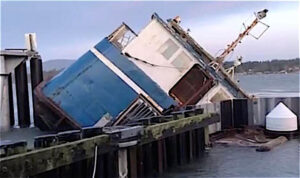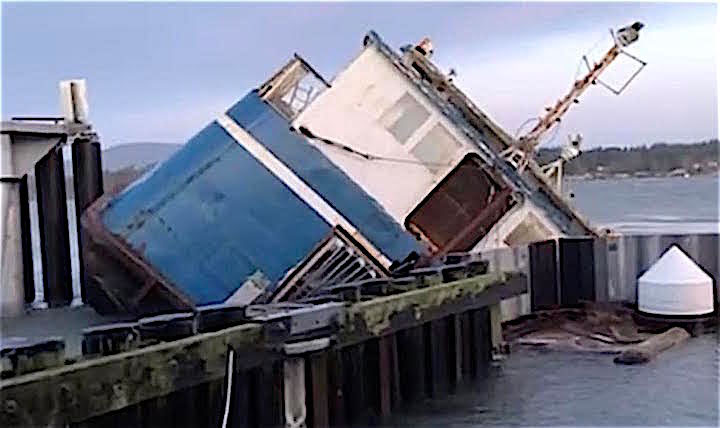Two historic vessels broke free and one sank in Anacortes, Wash., after the concrete pier to which they were tied collapsed during a fierce winter storm.
The 99-foot Chilkat and 213-foot Acushnet both went adrift in Guemes Channel after the 300-by-60-foot pier segment sank at Lovric’s Sea-Craft at about 0230 on Jan. 13. A third vessel, the tugboat Helen S., also broke free and became snagged in mooring lines, the U.S. Coast Guard said.

An assist tugboat corralled Acushnet, a World War II-era salvage ship turned Coast Guard cutter, said service spokesman Steve Strohmaier. The 64-year-old Chilkat, the first purpose-built ferry for Alaska’s burgeoning marine highway system, was not so lucky. It rolled over and sank near the Guemes Island Ferry Terminal later that morning.
John Lovric, vice president of Lovric’s Sea-Craft, said the pier segment took on water in the hours before it sank. How and why that happened likely won’t be determined until after the section is refloated.
“We don’t know yet if one of those boats punched a hole in the side. Maybe it was bouncing or knocked the fenders loose, but that is what we believe happened at this time,” Lovric said in a phone interview. “It didn’t pull the boats down with it, but it snapped their mooring lines.”
A powerful storm on the night of Jan. 12 and morning of Jan. 13 brought heavy rain and 40-knot winds, Strohmaier said, with gusts reaching 50 knots. Seas in Guemes Channel were 4 to 5 feet.
After the vessels broke free from the boatyard, the wind blew them northeast along the channel, Strohmaier said. The tugboat Garth Foss brought Acushnet under control and towed it to the Port of Anacortes undamaged, but the tug could not respond to Chilkat in time.
The decommissioned vessel lodged against the Guemes Island Ferry Terminal and took on water, likely through an opening cut in the stern. It eventually capsized and was pulled away from the terminal by the current before sinking in 35 feet of water. Commercial salvage crews marked the vessel’s location. Details on a possible salvage were not available at press time.
Ferry service from Juneau to nearby communities in southeast Alaska started in the late 1940s with a private operator. Private service proved untenable, and in 1957 the territorial government took over the operation. Chilkat, with its bow ramp capable of landing on beaches, was a workhorse that served the state for more than three decades.
The 59-passenger, 15-vehicle ferry built by J.M. Martinac Shipbuilding entered service in June 1957, two years before Alaska became a state and six years before the Alaska Marine Highway System began formal operations. Chilkat was retired in late 1988.
The ferry holds a special place in the hearts of many Alaskans, particularly residents in the state’s rugged and remote southeast region, according to Robert Venables, executive director of the Southeast Conference. The nonprofit group formed more than 60 years ago in part to advocate for a robust marine transportation system.
“Chilkat was the first vessel that began daily dependable service between communities. From that point on, other boats were built and other communities served,” Venables told Professional Mariner. “To see Chilkat go down like it did … was kind of heartbreaking. It was once a great asset for the state.”
Many Alaskans remember Chilkat as the first “blue canoe” — the nickname bestowed on Alaska State Ferry vessels. Mariners who worked aboard the ferry considered it the “queen of the fleet,” said Capt. William Hopkins, who joined the Alaska Marine Highway System as a mate in December 1977. He retired in 2007 and now lives in Ketchikan.
His first assignment as captain, in 1988, was aboard Chilkat. The vessel served as a proving ground and training platform for a generation of ferry system captains, Hopkins said in an article commemorating the ferry for the Alaska Marine Highway System’s 50th anniversary in 2013.
“Every new captain was assigned to Chilkat first,” Hopkins said in an email. “After that experience, everything else seemed easier.”
After it left the ferry system fleet, Chilkat worked briefly as a fish processor and later as a scalloper for a fishing operator. Its interior components were removed and the hull underwent modifications.
“It should be noted that Chilkat had been greatly modified (after decommissioning) and was hardly recognizable from her original profile,” Hopkins said.
The former cutter Acushnet has a similarly noteworthy past. It was built as USS Shackle in 1943 and served as a U.S. Navy salvage and rescue ship during World War II. Its crew supported the invasions of Iwo Jima and Okinawa in 1945. After the war, the vessel joined the Coast Guard fleet, where it was used for international ice patrols, maritime research and finally, in the late 1990s and early 2000s, Bering Sea patrols. It was decommissioned in 2011.
The sunken pier segment at Lovric’s has some history of its own. The boatyard used two sections, one 300 feet long and the other 270 feet long, as a floating pier. Both were initially part of the Lacey V. Murrow Memorial Bridge in Seattle, a portion of which sank in November 1990. It is the second-longest floating bridge in the world.
Lovric plans to refloat the pier section in the near future. “Hopefully we can see what damage there is and refloat it,” he said. “Hopefully whatever it is, it is minimal and we can get it back into service.”
Casey Conley

